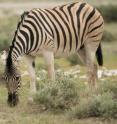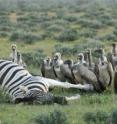New, unusually large virus kills anthrax agent
Related images
(click to enlarge)
From a zebra carcass on the plains of Namibia in Southern Africa, an international team of researchers has discovered a new, unusually large virus (or bacteriophage) that infects the bacterium that causes anthrax. The novel bacteriophage could eventually open up new ways to detect, treat or decontaminate the anthrax bacillus and its relatives that cause food poisoning. The work is published Jan. 27 in the journal PLOS One. The virus was isolated from samples collected from carcasses of zebras that died of anthrax in Etosha National Park, Namibia. The anthrax bacterium, Bacillus anthracis, forms spores that survive in soil for long periods. Zebras are infected when they pick up the spores while grazing; the bacteria multiply and when the animal dies, they form spores that return to the soil as the carcass decomposes.
While anthrax is caused by a bacterium that invades and kills its animal host, bacteriophages, literally "bacteria eaters" are viruses that invade and kill bacterial hosts.
The first thing the team noticed was that the virus was a voracious predator of the anthrax bacterium, said Holly Ganz, a research scientist at the UC Davis Genome Center and first author on the paper.
They also noticed that the new virus, named Bacillus phage Tsamsa, is unusually large, with a giant head, a long tail and a large genome, placing it among the largest known bacteriophages.
Tsamsa infects not only B. anthracis but also some closely related bacteria, including strains of Bacillus cereus, which can cause food poisoning. Sequencing the genome allowed researchers to identify the gene for lysin, an enzyme that the virus uses to kill bacterial cells, that has potential use as an antibiotic or disinfecting agent.
Bacteriophages are often highly specific to a particular strain of bacteria, and when they were first discovered in the early 20th century there was strong interest in them as antimicrobial agents. But the discovery of penicillin and other antibiotics eclipsed phage treatments in the West, although research continued in the Soviet Union.
"With growing concerns about antibiotic resistance and superbugs, people are coming back to look at phages," said Ganz said.
One advantage of bacteriophages is that because they tend to be very specific, they can potentially target only "bad" bacteria while leaving beneficial bacteria unharmed. Also, phages evolve with the host and have the potential to overcome bacterial resistance, said coauthor Jochen Klumpp of the Institute of Food, Nutrition and Health, ETH Zurich.
Ganz began the work as a postdoctoral scientist on a team led by Wayne Getz, Professor of Environmental Science, Policy and Management at UC Berkeley and at the University of KwaZulu-Natal, South Africa. Sequencing of the phage genome was conducted at UC Davis after Ganz joined the laboratory of Professor Jonathan Eisen.
Ganz said that she hoped the publication of the phage's sequence information would enable other researchers to investigate further and potentially develop applications for the phage and its proteins.
"You might use it to detect the anthrax bacillus or B. cereus; use it as an alternative to antibiotics or as part of a decontaminant," she said.
Source: University of California - Davis
Other sources
- New, giant virus kills anthrax agentfrom Science DailyTue, 28 Jan 2014, 3:30:45 UTC
- New, unusually large virus kills anthrax agentfrom PhysorgMon, 27 Jan 2014, 22:00:46 UTC


